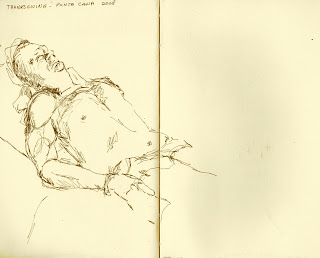
Last summer when we attended a college roommate reunion in Colorado, our friend Linda made the group a specialty from the 1970s, a Harvey Wallbanger cake. For the uninitiated, a Harvey Wallbanger was a sweet cocktail made from Galliano and orange juice. The cake won't make you tipsy, but it does have a nice orange flavor. I decided to make one for myself for my birthday. The recipe follows.

December 29th was one of the first mild December days and evenings, so I talked my husband into going out to Rotary Gardens for their annual holiday event. The visitor center featured around two dozen beautiful handmade quilts, and a huge train set. This year there was a circus train, and a model circus, honoring Wisconsin's role in circus history. The little children and the big ones too were fascinated.

The gardens themselves were lit with thousands of lights, and visitors could walk along the paths to see the snowy fairyland volunteers had created. Apart from the usual forms like this cactus, there were white lights arching over luminaria lit paths, and a tableau across the pond, that was reflected in the water. All in all, it made for a festive birthday.
Harvey Wallbanger Bundt Cake
1 box orange cake mix (if you can't find orange, substitute a yellow mix)
1 cup vegetable oil
4 eggs
1/4 cup Galliano
1/4 cup vodka
1 3 oz. package vanilla instant pudding mix
3/4 cup orange juice
Preheat the oven to 350 degrees. Generous grease and flour a bundt pan.
In a large bowl whisk together the cake and pudding mix, then set aside. In a medium bowl whisk together the oil, eggs, Galliano and vodka, and orange juice. Add the wet ingredients to the dry and mix at medium speed three minutes, until smooth.
Bake the cake 45 to 50 minutes, or until a skewker inserted comes out clean. Cool in the pan ten minutes, then tip out onto a serving plate. Glaze while still warm. It makes a nice moist cake that is even better with a bit of whipped cream.
Glaze:
1 cup powdered sugar
1 tablespoon orange juice
1 tablespoon Galliano
1 teaspoon vodka
Mix together until smooth, then drizzle over the warm cake. It works well to spoon the glaze into a plastic sandwich bag, then cut off the tip and squeeze.




























